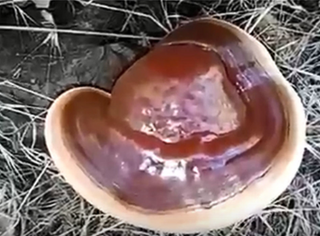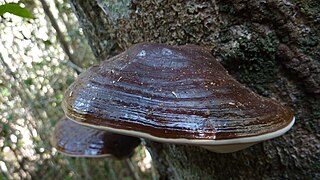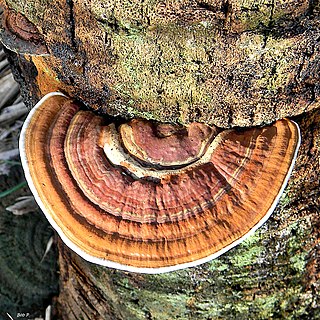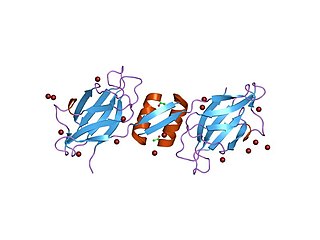
Mycelium is a root-like structure of a fungus consisting of a mass of branching, thread-like hyphae. Fungal colonies composed of mycelium are found in and on soil and many other substrates. A typical single spore germinates into a monokaryotic mycelium, which cannot reproduce sexually; when two compatible monokaryotic mycelia join and form a dikaryotic mycelium, that mycelium may form fruiting bodies such as mushrooms. A mycelium may be minute, forming a colony that is too small to see, or may grow to span thousands of acres as in Armillaria. The network of mycelium acts similar to human brains, in the way that mycelium is used to send electrical signals to the fruiting bodies of mushrooms. These electrical signals can be used to convey information or warn about incoming danger.

The Polyporales are an order of about 1800 species of fungi in the division Basidiomycota. The order includes some polypores as well as many corticioid fungi and a few agarics. Many species within the order are saprotrophic, most of them wood-rotters. Some genera, such as Ganoderma and Fomes, contain species that attack living tissues and then continue to degrade the wood of their dead hosts. Those of economic importance include several important pathogens of trees and a few species that cause damage by rotting structural timber. Some of the Polyporales are commercially cultivated and marketed for use as food items or in traditional Chinese medicine.

Polypores are a group of fungi that form large fruiting bodies with pores or tubes on the underside. They are a morphological group of basidiomycetes-like gilled mushrooms and hydnoid fungi, and not all polypores are closely related to each other. Polypores are also called bracket fungi or shelf fungi, and they characteristically produce woody, shelf- or bracket-shaped or occasionally circular fruiting bodies that are called conks.

Lingzhi, Ganoderma sichuanense, also known as reishi or Ganoderma lingzhi is a polypore fungus native to East Asia belonging to the genus Ganoderma.

Ganoderma lucidum is a red-colored species of Ganoderma with a limited distribution in Europe and parts of China, where it grows on decaying hardwood trees. Wild populations have been found in the United States in California and Utah but were likely introduced anthropogenically and naturalized.

Ganoderma applanatum is a bracket fungus with a cosmopolitan distribution.

Ganoderma is a genus of polypore fungi in the family Ganodermataceae that includes about 80 species, many from tropical regions. They have a high genetic diversity and are used in traditional Asian medicines. Ganoderma can be differentiated from other polypores because they have a double-walled basidiospore. They may be called shelf mushrooms or bracket fungi.

Ganoderma orbiforme – most commonly known as G. boninense or just Ganoderma in oil palm pathology – is a species of polypore fungus that is widespread across southeast Asia. It is a plant pathogen that causes basal stem rot, a disease of the African oil palm. The fungus was first described scientifically in 1838 by Elias Magnus Fries from collections made in Guinea. Leif Ryvarden transferred it to the genus Ganoderma in 2000. In addition to its type locality, the fungus has also been collected from the Bonin Islands in the Pacific, and from Venezuela and Puerto Rico.

Ganoderma tornatum is a fungal plant pathogen in the genus Ganoderma. It is a species of basidiomycete fungi in the family Polyporaceae. Members are also known as bracket fungi, or polypores.

Ganoderma zonatum is a plant pathogen that infects the palm species causing butt rot. It is a fungus that infects the bottom 122–152 centimeters of the plant also rotting the roots. It has been known to be in both natural and planted environments and in the majority of cases only in palms.

Ganoderma tsugae, also known as hemlock varnish shelf, is a flat polypore mushroom of the genus Ganoderma.
Humphreya is a genus of four species of polypore fungi in the family Ganodermataceae. The genus was circumscribed by Belgian mycologist René Léopold Steyaert in 1972. He proposed Humphreya as a genus segregate from Ganoderma, typified by Ganoderma lloydi Pat. & Har., and included Ganoderma coffeatum and the newly described Humphreya endertii. H. eminii was transferred to the genus by Leif Ryvarden in 1980.

Ganoderma curtisii is a wood-decaying polypore whose distribution is primarily in the Southeastern United States. Craig and Levetin claim to have observed it in Oklahoma.
Medicinal fungi are fungi that contain metabolites or can be induced to produce metabolites through biotechnology to develop prescription drugs. Compounds successfully developed into drugs or under research include antibiotics, anti-cancer drugs, cholesterol and ergosterol synthesis inhibitors, psychotropic drugs, immunosuppressants and fungicides.

Taiwanofungus is a fungal genus of unknown familial placement in the order Polyporales. The genus contains two species: the type, Taiwanofungus camphoratus, and T. salmoneus. Taiwanofungus was circumscribed by Taiwanese mycologists in 2004. T. camphoratus is a medicinal fungus that is found in Taiwan, where it grows on the endemic tree species Cinnamomum kanehirae. It was first described in 1990 by Mu Zang and Ching-Hua Su as a species of Ganoderma. T. salmoneus, originally placed in Antrodia, was validly added to the genus in 2012.
Scytalidium ganodermophthorum is an anthroconidial ascomycete fungus in the Scytalidium genus. It is also known by its teleomorph name Xylogone ganodermophthora. It is the cause of yellow rot in lingzhi mushrooms and it is used in spalting as a pigmenting fungi.

Ganoderma microsporum is a species of Ganoderma mushroom native to Taiwan that grows on willow trees.

Fungal immunomodulatory proteins (FIPs) are a type of functional compound found in various species of fungi. FIPs are part of the immunoglobulin (ig) family, which are structurally similar to human antibodies, and can interact with human peripheral blood mononuclear cells (PBMCs), causing these cells to secrete different types of hormones and regulate cellular activity.
Ganoderma microsporum immunomodulatory protein or GMI is a protein discovered from the mushroom species Ganoderma microsporum. GMI is a pure protein composed of 111 amino acids and exists in nature as a tetramer.















